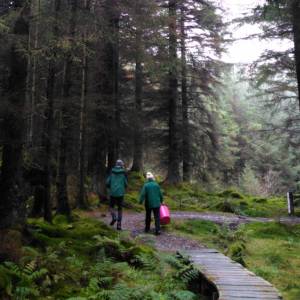Wild and Hairy Wood Ants
I knew nothing about Wood Ants, other than childhood memories of watching great piles of pine needles seething with large black ants in the forests of Sweden and Scotland and feeling the scurry of their feet over Start-rite sandals.
At the back of my mind I’ve always wondered why there are none, or very few, in the valleys of the Lakes. I was about to find out because on Wednesday I was lucky enough to go with our Wildlife Re-introduction Officer on a mission to translocate Wood Ants from Yorkshire to West Cumbria, as part of a re-wilding.
Wood Ants are found most prolifically in old undisturbed woodland, either deciduous or conifer. They are poor colonisers of new habitat. They do not fly far and so if habitat becomes fragmented, they cannot join up again. They react badly to nest destruction. Forest clearance does both these things and over time wood ants have dwindled and died out in many managed forests. Those at the donor forest have hung on in good numbers around the peripheral verges of the plantations.
We started out at 05.00 on a morning that was spectacular even for May, with a huge pink full moon setting and the sun rising in blues and golds on the opposite sides of the horizon. The 2 vans were loaded with large boxes, spades, ant-repellent and PPE. Translocation is not something to do lightly – there are so many things that can go wrong, not least the death of the subjects. Our officer has put in a huge amount of time into research and contacting the people most knowledgeable about wood ants for advice and site visits beforehand.
When we arrived, we went straight to one of the pre-marked nests. Despite the cool cloud cover it was busy with hundreds of workers moving material up and down the metre high nest pile. A luckless millipede was also being transported like an unruly roll of carpet. This was just for a high protein snack, I found out; their main food is the sugary waste products of tree aphids. It’s nice to think of them being the ‘milkmaids of the forest’ but in fact it all looked extremely chaotic and bitey. We donned blue coveralls, well tucked into socks, and gloves, well tucked into sleeves and goggles, because once they are disturbed, they emit a fine sweet-sour vapour of formic acid.
We were taking entire nests on this trip so if you can imagine that the mound is a chocolate layer cake, it was important to take one layer off at a time and place each in separate boxes. The idea is that, when they reach their destination, they will be re-assembled in reverse order. The first layer was very friable and light, just the thatched roof of the colony, but still swarming with now very upset inhabitants. Ants and all were placed in the first box. To stop them immediately surging out again ant enthusiasts have developed an ant repellent liquid that we wiped on around the top edges of the boxes so that not one ant clambered over. To make doubly sure we also taped cotton cloth lids on securely. Even so, there was a nightmarish vision at the back of everyone’s mind that they might all escape into the cab whist we were driving up the motorway.
As we progressed down the layers the material became slightly more compacted and we could see winged ants – potential queens or drones that are the basis of new colonies. The fat creamy paella grains of the hundreds of eggs also came into view. Any Mafia activity towards us was completely re-directed into saving these bambini and taking them deeper into the nest. At last, we hit earth, roots and the remains of an old stump riddled with solid looking galleries. This layer went into the sixth box and covered, like a coffin full of living earth ready to resurrect.
Altogether we dug up 4 nests and by mid-afternoon the three hour journey home began with the vans full of the sweet smell of acid and on the edge of hearing, the soft susurration of a million ants - still working.
- 1
- 0

Comments
Sign in or get an account to comment.


